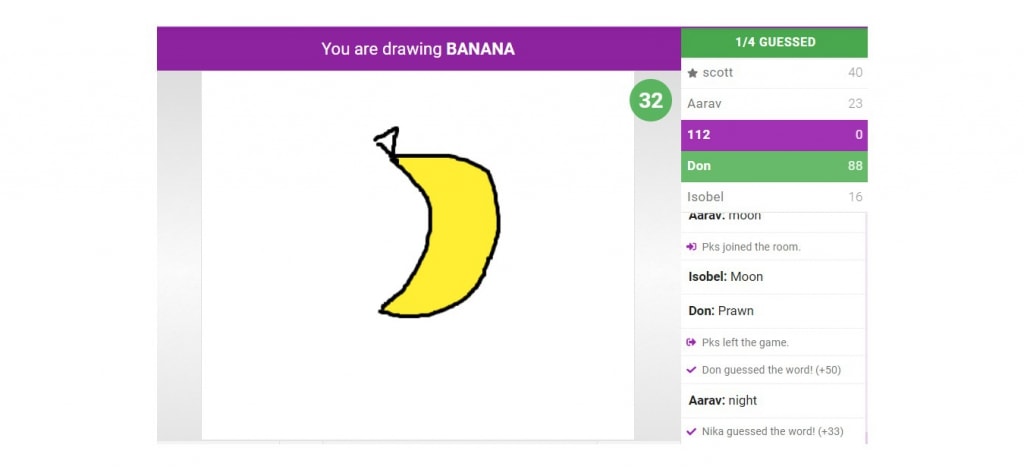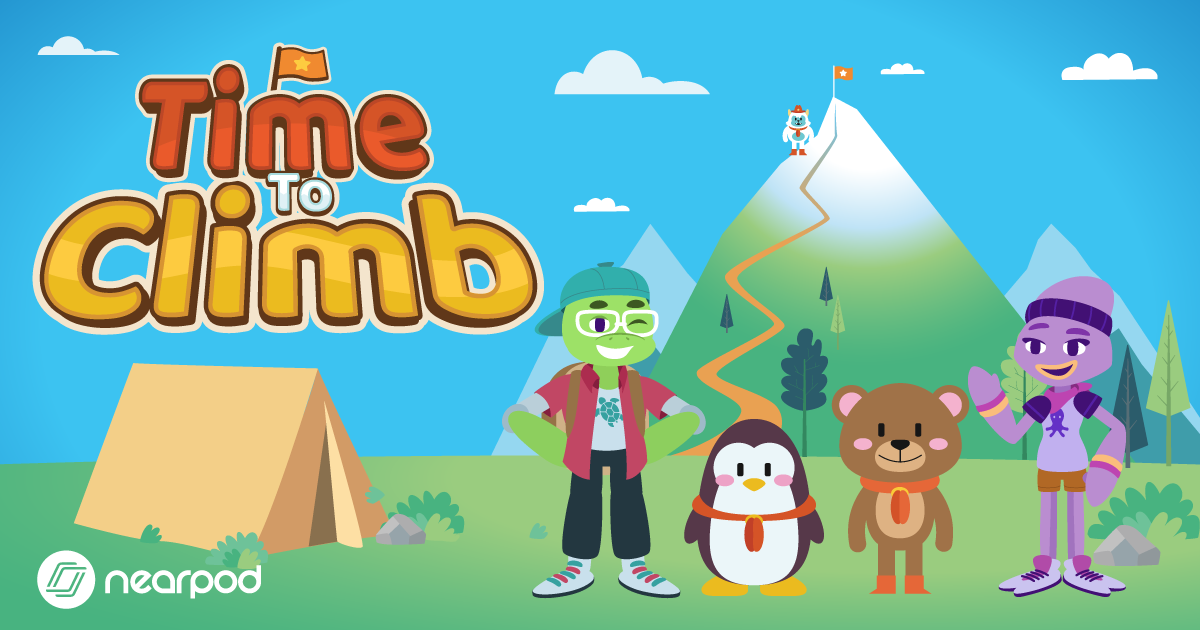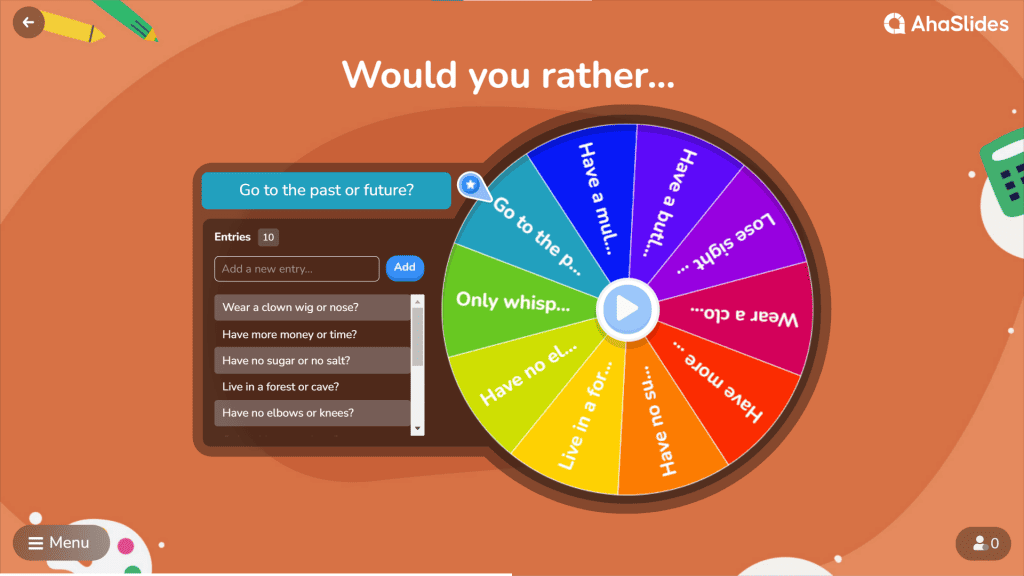12 Exciting ESL Classroom Games with Almost Zero Prep (for All Ages!) – AhaSlides
There’s a lot of nerves flying around the typical ESL Classroom Games. Students often shy away and offer stuttered responses in fear of public judgement.
Teaching a language isn’t all fun and games, but actually, it can be. ESL classroom games are not just an enjoyable break from textbooks, they also help your students revise vocabulary, learn new structures and, crucially, practice English in a fun, encouraging environment.
Below you’ll find 12 low-prep, 17 fun games to play in class for English learning (both online & offline) and how to make them.
Mục lục bài viết
Let the Fun Begin with…
💡 Looking for exclusively online classroom games for remote learning? Check out our list of 15!
ESL Classroom Games for Kindergarten
It’s a simple fact that kids practice English best through play. ESL classroom games for kindergarteners should be easy, have simple rules and make them move around to work off their surplus energy.
Game #1: Simon Says
Simon says, ‘Play this game!’. This is one of the most iconic and classic ESL classroom games you’ve probably ever known; I bet that we all played this game in a fit of giggles when we were little.
Without a doubt, Simon Says is the easiest game to host in your ESL class. You don’t have to prepare anything except your childlike soul to join the fun with the kids. Get your students up and moving with this easy, delightful game!
Choose some verbs you want to teach your kids. The best ones are those that make the kids move around or do some goofy stuff; we promise you they’ll be in fits of laughter by the end.
 ESL Classroom Games
ESL Classroom Games
How to play
- You are the Simon in this game. After a few rounds, you can choose another student to be Simon.
- Choose an action and say out loud ‘Simon says [that action]’, then the children must do it. You can do that action when saying or simply just say it.
- Repeat this process several times with different actions.
- When you like, only say the action without the phrase ‘Simon says’. Whoever does that action is out. The last one in the game is the winner.
- You can do this both in class or during virtual lessons, but in the latter case, tell them to do something in front of the camera so you can watch.
Game #2: Wheel of Fortune
Nothing attracts the kids more than some colourful spinner wheel full of surprises, right? It’s a great engager for a stress-free knowledge or homework check.
Your spinner wheel contains different scores in this game, from low to high. You can choose whatever scores you want, but the small kids tend to love big numbers!
With a touch of technology, you can have an online spinner wheel in just a few clicks. You can make one and get some great classroom ideas in this quick guide.
How to play
- Divide your class into teams. You can let them decide their teams’ names, or use numbers/colours instead.
- In every round, choose someone from each team and ask them a question or ask them to finish a task.
- When they’ve done it right, the kids can spin the wheel to get a random score for their teams.
- Eventually, the team with the highest score wins.
ESL Classroom Games
Game #3: Musical Chairs
There are few ESL classroom games for students better than Musical Chairs when it comes to music and exercise. Which kid can reject running around to catchy English tunes and flexing their fast reactions?
Put a vocabulary flashcard on each chair to make the most out of it. When students sit on the chair (and flashcard), they have to shout out the vocab word before the next round can start.
This game is definitely worth the hype. It’s enjoyable, easy to play, and most importantly, it gets your students up and moving instead of sitting stiffly in their chairs.
How to play
- Grab a chair for each student, minus one.
- Arrange the chairs in a circle, back to back.
- Place a vocabulary flashcard on each chair.
- Instruct the children to walk clockwise around the chairs while the music plays.
- Stop the music suddenly. Each student must sit quickly on a chair.
- The student without a seat will be out of the game.
- Quickly go around each student and ask them for the vocabulary word on their flashcard.
- Take out another chair and continue the game until there is only one chair left.
- The only child to sit on that chair and announce the flashcard is the winner!
Game #4: Tell Me Five
This class ESL game is straightforward and takes zero time to prepare. It’s great for spontaneously getting young students talking or brainstorming in teams.
You can let them play Tell Me Five to test their memories and vocabulary. It’s a fun, excellent and simple brain practice for the kids.
 ESL Classroom Games
ESL Classroom Games
How to play
- Make a list of categories such as colours, food, transportation, animals, etc.
- Put students into teams of 2, 3 or 4.
- Ask them to choose a category based on what they like, or randomly choose one using a spinner wheel.
- If the student selects the animals category, the teacher can say “Tell me 5 wild animals” or “Tell me 5 animals with 4 legs”.
- Students have one minute to come up with all 5.
ESL Classroom Games for K12 Students
Here we get a bit more advanced. These ESL classroom games for K12 are fantastic replacements for boring assignments, as well as fun ice breakers that can do wonders for their English and their confidence.
💡 By the way, this is the perfect age group to start introducing some classroom maths games, general classroom online games…
Game #5: Alphabet Chain
Alphabet Chain deserves its place at the top of the ESL classroom games list for K12 students. You can be surprised by your students’ creativity and fast thinking.
This one is often a go-to in classes or parties when no one can think of a more simple game. It never gets old and requires no effort to prepare.
How to play
- While holding a ball, say a word.
- Throw the ball to another student.
- The student who catches it says a word starting with the last letter of the previous word, then throws the ball onwards.
- Any student who can’t think of a word within 10 seconds is eliminated.
- The game continues until there is only one student left.
Game #6: Pictionary
The game is another all-time favourite in heaps of classrooms. Challenge your students to produce what they can, whether it be a masterpiece from a potential Picasso or some simple-minded scribbles.
The whole class can play Pictionary individually or in teams. All you need is some paper and pencils, or you can use the board and some markers or chalks instead.
If you host this game online, you can even find young talents to become future graphic designers.
Small tip: When you want to check your students’ memories and level up the game, you can ask them to spell the word after saying the correct answer.
How to play online
 ESL Classroom Games
ESL Classroom Games
- Access Drawasaurus.
- Choose the ‘Private room’ option to create a virtual space for your class. Remember to change the setting to ‘Private’ if you don’t want to have any outsiders.
- Share the participating link to invite your students to join the room.
- Choose a word among suggested options and all students must guess the word being drawn.
- Whoever says the correct answer first gets 1 points. Whoever gets 5 points first will win.
Game #7: Vogue’s 73 Questions
Ever heard of Vogue’s 73 Questions series with celebrities? Well, your students don’t have to be celebrities to join this quick game.
Students must answer some open-ended questions in a short time; they need to think really fast and should say what first comes to mind. It’s a great way to warm up or fill up some last minutes of your lessons as well as check your students’ vocab and writing skills.
Using a brainstorming tool means that everyone can submit their answers to a question before the whole class votes on their favourite answer.
To level up the game for middle and high schoolers, ask some of them to explain their answers in a few sentences.
How to play using AhaSlides’ brainstorming tool
 ESL Classroom Games
ESL Classroom Games
- Get a list of questions.
- Sign up to AhaSlides for free.
- Create a presentation and add some brainstorm slides with your questions.
- Share the join link with your students.
- Give them 30 seconds to send answers to each question from their phones.
- Take it to the next round and let your class vote for their favourite.
- Who receives the most ‘likes’ in total wins the game.
Game #8: Time to Climb
Time to climb is an online learning game by Nearpod, a platform that provides many ESL classroom games and activities. It takes class engagement to the next level with friendly competition while assessing your students’ knowledge.
It’s a multiple-choice quiz game that can be played live or in student-paced mode, with the ultimate aim to reach the peak of the mountain.
The concept is super simple, but Time to Climb works well for engaging youngsters with colourfully designed themes, animated characters, and catchy background music.

 ESL Classroom Games
ESL Classroom Games
How to play
- Sign up for a free Nearpod account.
- Create a new lesson then add a slide.
- From the Activities tab, choose Time to Climb.
- Enter the questions and multiple answers in the provided box.
- Add more questions to your game.
- Send the participant link to your students or give them a link to play at their pace.
ESL Classroom Games for University Students & Adults
In class, university students and adult learners tend to be a lot more shy than when they were younger. Below are some more technical and advanced ESL classroom games for adults.
Game #9: Trivia
Sometimes the best ESL school games are the most straightforward. A virtual quiz is one of the proven ways to test students’ knowledge on pretty much anything. The game can be competitive, fun and loud; a lot of it depends on the questions and your hosting skills.
Quiz technology is everywhere nowadays, and it’s revolutionised the way we do trivia. There are always free tools to use both in-class and online for a live ESL quiz with beautiful visuals (or sounds).
How to play using AhaSlides
 ESL Classroom Games
ESL Classroom Games
- Create a free account.
- Create a presentation and add a quiz slide.
- Make your question, then rinse and repeat (or just grab a template!)
- Share the link to your game and press ‘Present’
- Students join on their phones and answer each question live.
- Scores are tallied up and the winner is announced in a shower of confetti!
Game #10: Never Have I Ever
The queen of the party is here! This classic drinking game is one of the most fascinating ESL classroom games to test your students’ grammar and vocabulary.
Give them only 10 seconds to think and share, because time pressure makes this game a lot more fun. You can let your students go wild with their minds or give them a theme for each round, which could be the main topic of the lesson or a unit you’ve been teaching them so that they can revise.
How to play
- Students raise 5 fingers in the air.
- Each of them takes turns to say a thing they have never done, starting with ‘Never have I ever…’
.
- If anyone has done the mentioned thing, they need to put a finger down.
- Whoever puts down all 5 fingers first loses.
Game #11: Classmate Speculation
Students will love this game once they get the hang of it! This guessing game tests how your students understand their classmates and practice their grammar, speaking and listening skills. You can use it anytime during the course; it’s especially great at the beginning when students or learners want to know more about each other.
Classmate speculation is another game where you don’t have to prepare anything but some target verbs.
How to play
- Provide students a set of words with which they make sentences, like, go, can, dislike, etc.
- A student will think of or guess a fact about another one and say ‘I think that’. The sentence must contain a provided word. For example, ‘I think that Rachel dislikes playing piano’. You can make it harder by asking students to paraphrase given words, use more than 1 tense and complex grammar structures.
- The mentioned student will then confirm whether the information is true or not. If it’s true, the one who says it gets a point.
- Whoever gains 5 points first will win.
Game #12: Would you Rather
Here’s a simple ice breaker that can be great for starting productive student debates and informal discussions in class.
The topics for Would you Rather can be genuinely outrageous, such as ‘would you rather have no knees or no elbows?’, or ‘would you rather have ketchup on everything you ate or mayonnaise for eyebrows?’
Grab a free spinner wheel template loaded with Would you Rather questions. Perfect for the classroom!
 ESL Classroom Games
ESL Classroom Games
How to play
- Choose from a big list of Would you Rather questions.
- Students can have up to 20 seconds to come up with an answer.
- Encourage them to share more by asking them to explain their reasoning. The wilder, the better!











